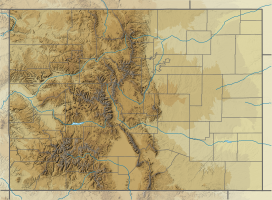geo.wikisort.org - Mountains
Mount Ridgway is a 13,468-foot-elevation (4,105 meter) mountain summit located in Ouray County of southwest Colorado, United States.[3] It is situated five miles west of the community of Ouray, on land managed by Uncompahgre National Forest. It is part of the Sneffels Range which is a subset of the San Juan Mountains, which in turn is part of the Rocky Mountains. It is west of the Continental Divide, 2.2 miles east-northeast of Mount Sneffels, and 0.95 miles southwest of Whitehouse Mountain, which is the nearest higher neighbor.[1] Topographic relief is significant as the west aspect rises 3,000 feet (914 meters) above Blaine Basin in one mile.
| Mount Ridgway | |
|---|---|
 North aspect | |
| Highest point | |
| Elevation | 13,468 ft (4,105 m)[1] |
| Prominence | 428 ft (130 m)[1] |
| Parent peak | Whitehouse Mountain (13,492 ft)[2] |
| Isolation | 0.94 mi (1.51 km)[2] |
| Coordinates | 38°00′49″N 107°45′11″W[3] |
| Naming | |
| Etymology | Robert M. Ridgway |
| Geography | |
 Mount Ridgway Location in Colorado  Mount Ridgway Mount Ridgway (the United States) | |
| Location | Ouray County Colorado, US |
| Parent range | Rocky Mountains San Juan Mountains Sneffels Range[1] |
| Topo map | USGS Mount Sneffels |
| Geology | |
| Type of rock | Extrusive rock |
| Climbing | |
| Easiest route | class 2 hiking[2] |
Etymology
This mountain, the nearby town of Ridgway, the Ridgway Dam, and Ridgway State Park trace their names to Denver & Rio Grande Railroad superintendent Robert Matthew Ridgway (1834–1908), who established the town in 1891.[4][5] The mountain's name has been officially adopted by the United States Board on Geographic Names.[3]
Climate
According to the Köppen climate classification system, Mount Ridgway is located in an alpine subarctic climate zone with long, cold, snowy winters, and cool to warm summers.[6] Due to its altitude, it receives precipitation all year, as snow in winter, and as thunderstorms in summer, with a dry period in late spring. Precipitation runoff from the mountain drains into tributaries of the Uncompahgre River.
Gallery
See also
- Mountains of Ouray County, Colorado
References
- "Mount Ridgway, Colorado". Peakbagger.com.
- "Ridgway, Mount - 13,468' CO". listsofjohn.com. Retrieved 2021-07-03.
- "Mount Ridgway". Geographic Names Information System. United States Geological Survey. Retrieved 2021-07-03.
- Dawson, John Frank. Place names in Colorado: why 700 communities were so named, 150 of Spanish or Indian origin. Denver, CO: The J. Frank Dawson Publishing Co. p. 43.
- Liobrary of Congress
- Peel, M. C.; Finlayson, B. L.; McMahon, T. A. (2007). "Updated world map of the Köppen−Geiger climate classification". Hydrol. Earth Syst. Sci. 11. ISSN 1027-5606.
External links
- Weather forecast: Mount Ridgway
Другой контент может иметь иную лицензию. Перед использованием материалов сайта WikiSort.org внимательно изучите правила лицензирования конкретных элементов наполнения сайта.
WikiSort.org - проект по пересортировке и дополнению контента Википедии

